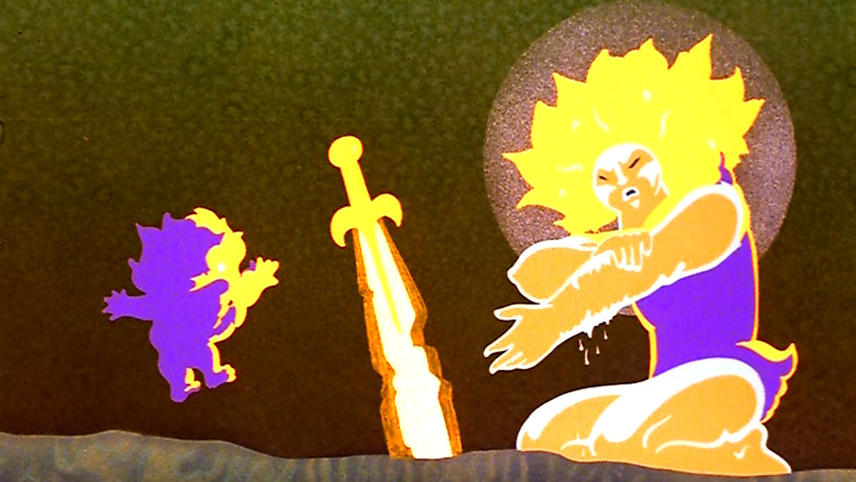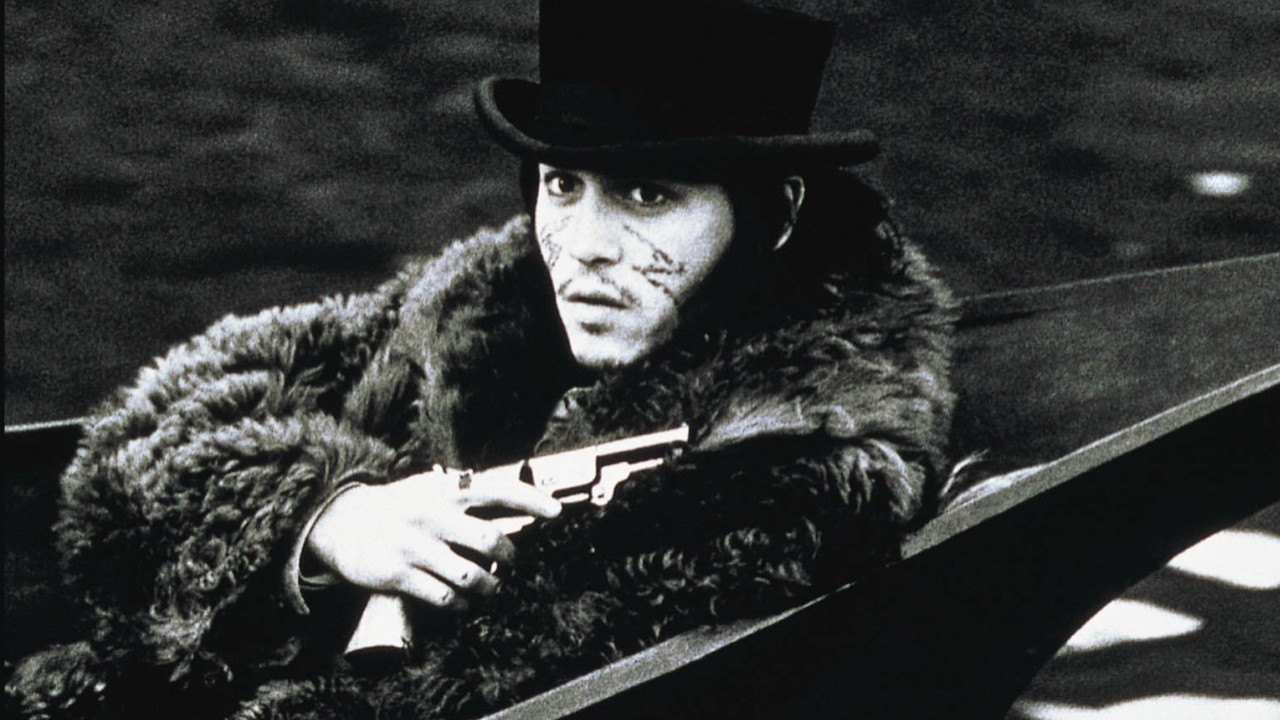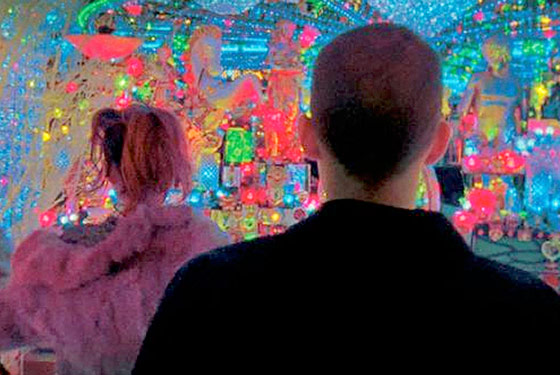18. Altered States (1980) dir. Ken Russell
Ken Russell’s foray into the science fiction genre explores the mystical experience of one man’s hallucinations and the concept of these hallucinations becoming phyisically manifest. The film’s psychedelic sequences are vivid visual representations of the protagonist’s psychological devolution into increasingly primative forms of being.
A psychologist, Edward Jessup (William Hurt), fascinated with altered states of consciousness, undertakes a scientific experiment wherein he takes hallucinatory drugs while in a sensory deprivation tank. The combination of an untested Native American drug and sensory deprivation cause him to mentally and physically degenerate from man to proto-human to primordial being.
The sequences depicting Jessup’s hallucinations utilize bright colors and fast editing in order to show the viewer his altered sensory perceptions. We see religious and primal symbology, suggesting Jessup’s spiritual associations with his memories and unconcious thoughts. Toward the end of the film, his hallucinations become a wild daze of microscopic cellular movement.
Altered States is an excellent melding of science fiction and psychedelia in film. The surreal imagery adds insight into the consciousness of the main character while under the influence of his mind-altering experiences. There is a certain level of suspense during Jessup’s transformations, which make it hard for the viewer to determine what is real and what’s imagined.
19. Son of the White Mare (Fehérlófia) (1981) dir. Marcell Jankovics
This 1981 Hungarian animation uses bright colors, symbolic, geometric shapes, and pulsating movement to tell the mythic tale of a man with superhuman strength, Fehérlófia, born from a white horse. The film, abundant with allusions to ancient Hungarian history and folktales, visually captures the magic embedded in fairy tales.
We follow Fehérlófia through his heroic journey to exact revenge on the dragons that imprisoned his mother years prior. The film begins with his mother running for shelter and giving birth to him in the hollow of a tree.
She tells her young son the story of how evil dragons overcame the magic kingdom and imprisoned her. After having two sons, who disappeared from the eyes of the dragons, she escaped, pregnant with Fehérlófia. As he grows older, Fehérlófia receives advice from the spirit of the Forefather to suckle at his mother’s breast for 14 years in order to become strong.
At the end of the 14 years, his mother dies of exhaustion and he leaves home with his newfound strength to find his long lost brothers. The three of them then journey to the underworld to find the dragons who jailed their mother.
The striking, prismatic visuals lead us through this adventure rich with folkloric archetypes and symbolism. Jankovics creates a magical world with this fantastic story told through the colorful, psychedelic animation. The entirity of this film is one swirling mass of sensory delight.
20. Come and See (Idi i smotri) (1985) dir. Elem Klimov
This twisted coming of age tale illustrates the horrors of war as seen and heard by a Belarussian boy during the Nazi occupation of the Soviet Union during the Second World War. The film’s haunting imagry and sound design appropriately places the viewer in the vulnerable position of the impressionable young man as he sees his village viciously destroyed.
Flyora (Aleksei Kravchenko) is digging in the sand, looking for a rifle in order to join the Soviet forces. Once he finds his weapon, the wide-eyed youngster marches off to become a soldier, much to the dismay of his mother. On his troop’s first mission, Flyora is left behind with a beautiful young woman, Glasha (Olga Mironova), the troop’s nurse. German warplanes circle overhead and drop bombs on their camp site, deafening Flyora.
The film follows Flyora as he journeys back to his village, only to find it ravaged and occupied with sadistic Nazis. Once Flyora loses much of his hearing, the film takes a drastic turn, using warped sounds to mimic the sounds Flyora can hear. The drone of the airplanes overhead, the muffled voices of the people around him, and imagined radio broadcasts create the symphony of sound that permeate Flyora’s broken psyche.
At the start of the film we are presented with a bright eyed, bushy tailed boy ready for the adventures of war. However, we are only to see him traumatized and prematurely aged; he is driven mad by the terrors of death. The sound design mixed with the powerful performances (which oftentimes break the fourth wall) create a living nightmare that enmeshes the audience within the tortured mind of Flyora.
21. Dead Man (1995) dir. Jim Jarmusch
Jim Jarmusch’s atmospheric, existential western takes the viewer on the lonely, dreamy journey (accompanied by the sparse, electric strummings of Niel Young) of William Blake (Johnny Depp) as he finds himself wandering through a forest, led by a Native American named Nobody (Gary Farmer).
William Blake comes to the rusty industrial town of Machine with the prospects of a job. After his job falls through, he kills a man out of self-defense, and wounded, steals a horse and rides out of town. Nobody finds him unconcious in the woods and after learning William Blake’s name, thinks he is a reincarnation of the Romantic poet. William Blake takes a spiritual journey with Nobody through the white winter forest, realizing his place as a “dead man.”
Jarmusch himself dubbed the film a “Psychedelic Western,” and Dead Man lives up to the name through the use of Robby Müller’s exquisite, otherworldly black and white photography, Niel Young’s intense, yet minimal, music, and the philosophic musings of the characters.
22. Fear and Loathing in Las Vegas (1998) dir. Terry Gilliam
Based on Hunter S. Thompson’s novel (using semi-autobiographical events), Fear and Loathing in Las Vegas takes the viewer on a two hour psychedelic trip to the heart of debauchery. Consisting mostly of distorted caricatures and hallucinations, the film successfully envelops the viewer in the drug-fuelled reality of the characters.
Hunter S. Thompson’s alter-ego Raoul Duke (Johhny Depp) and his attorney, Dr. Gonzo (Benicio del Toro) take a road trip to Las Vegas from Los Angeles on the assignment of covering the Mint 400 motorcycle race. The pair feast upon their collection of illegal drugs, making their stay in Vegas memorable (well, from what they can remember). Duke narrates their indulgent exploration, bringing up themes of the American Dream.
In what could be considered the director’s cult masterpiece, Gilliam distorts the reality of the characters to the point of ridicule. As Duke and Gonzo cavort through the extravagant city of Las Vegas, with a multitude of drugs turning an already bizarre environment chaotic, they hit upon the emptiness of American culture.
23. Requiem for a Dream (2000) dir. Darren Aronofsky
Aronofsky’s melodramatic tragedy is a brutal tour de force. Depicting the mountainous highs and devastating lows of drug use and addiction, Requiem for a Dream goes far beyond any other cautionary tale with its horrifyingly distorted visuals, heartbreaking scenarios, and epic musical score.
The film follows four characters, Harry (Jared Leto), his mother Sara (Ellen Burstyn), Harry’s girlfriend Marion (Jennifer Connelly), and Harry’s best friend and drug dealing partner Tyrone (Marlon Wayans). Each character struggles to accomplish his or her ambitions, but is ultimately overtaken by their drug addition: Harry, Marion, and Tyrone to heroin and Sara to amphetamines in disguise as diet .
Aronofsky amplifies the drug use with continual close up shots of the characters injecting or ingesting their drug of choice. We see the routine that begins to develop and how it leads to the characters’ ultimate downfall. Visual and auditory hallucinations abound as the characters all try to maintain a grasp on their goals and in some instances, reality. Each characters’ descent is illustrated beautifully with Aronofsky’s masterful direction, with his emphasis on the distortion of reality that comes with drug use.
24. Enter the Void (2009) dir. Gaspar Noé
Gaspar Noé’s frightening, hallucinatory masterpiece is a sensory overload of bright lights and neon colors, a swirling soundscape, and unparalled visual effects. Noé’s hardcore mind trip transports the viewer into a phantasmagoric world of life, death, and nightmare.
Loosely based on the Tibetan Book of the Dead, the film follows Oscar (Nathaniel Brown), an American, Toyko-based drug dealer and his sister Linda (Paz de la Huerta). Oscar and Linda were orphaned at a young age, when their parents died in a car crash (that they were also in). The two promise to always stick together, and Oscar swears to protect Linda, no matter what.
One night, Oscar meets up with his friend Alex (Cyril Roy) on his way to a bar to sell some product to a young guy. The meeting turns out to be a set up, and Oscar is shot and killed by the police. For the rest of the film, Oscar’s spirit floats through the streets of Toyko reexperiencing old memories, watching over Linda and Alex, and delving into alternate versions of reality.
Told completely from Oscar’s point of view (the camera mimicks Oscar’s vision and hearing), the film captures every aspect of Oscar’s sensory perceptions, including a five minute DMT trip at the beginning of the film. The maelstrom of dazzling lights, neon colors, and distorted imagry that the viewer encounters both before and after Oscar’s death is nothing short of a tour de force in psychedelic filmmaking.
25. A Field in England (2013) dir. Ben Wheatley
A film made up of only five characters in one location, A Field in England takes the viewer on a psychological trip involving war deserters, witchcraft, and the supernatural.
Set during the English Civil War, an alchemist’s assistant, Whitehead (Reece Shearsmith) and three other deserters wander through the English Countryside in search of an ale house. The men come across a mysterious Irishman named O’Niell (Michael Smiley), whom Whitehead soon realizes is the man he was instructed by his master to find in order to obtain some stolen manuscripts. However, O’Niell pursuades the group of men to help him search and dig for a treasure buried in a specific field within a fairy ring, where the men soon unravel.
Ben Wheatley (Kill List, Sightseers) incorporates history and folklore into his very simple, yet compelling and extremely psychedelic film. The ancient superstition behind mushroom circles say that all those who enter are transported into a magical (but dangerous) realm.
Wheatley plays upon that superstition with psychedelic sequences that include mirroring one side of the frame to the other, and very fast editing which disrupts the viewer’s persistence of vision to the point of assault (there’s even a notice at the start of the film warning the viewer about the “flashing images and stroboscopic sequences”). The film achieves the perfect blend of historical realism and occult psychedelia.
Author Bio: Esther Zeilig is a graduate from UCLA’s School of Film and Television, with an emphasis in Cinematography. She spends her free time doing what she loves: watching film, working on her photography, and snuggling with her cats.







